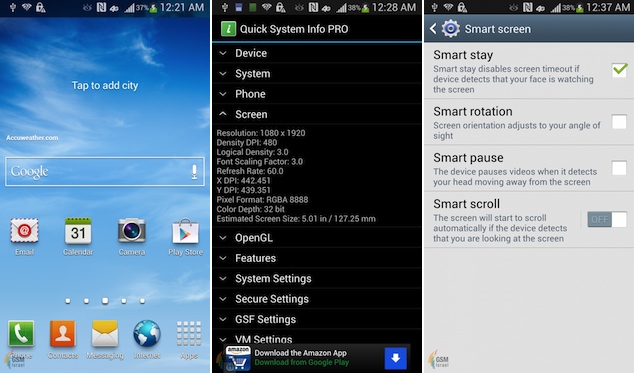

During my use of the handset, neither Air Gestures (hovering your hand over the proximity sensor) nor Air View features (hovering your finger/stylus above the display) proved to be useful at all in fact I likely would have saved time accessing information through traditional screen taps as opposed to trying to get gestures to work. Here you'll find everything from gesture controls to face detection features, most of which are extremely gimmicky and battery wasting. The Galaxy Note 3's settings is the main dumping ground for a number of the smartphone's 'features'.
Samsung note 4 smart scroll android#
Network indicators, removed in Android 4.4, still remain in the status bar, and there's also the option to place a battery percentage beside the battery indicator graphic, which is essential for keeping accurate track of your remaining life. The notification pane includes a range of quick settings in a panel that horizontally scrolls, along with a brightness bar that allows you to fine tune your screen level with relative ease. These days I find myself using fewer and fewer widgets, preferring to head straight into the relevant application, but some of the included widgets (such as S Planner) do offer lots of information at a quick glance. The homescreen is a standard 4x4 grid with a row of four interchangeable apps in the dock, and as always there are a range of Samsung-made widgets to use, many of which are quite large and will dominate the homescreen pane they're on.

Samsung note 4 smart scroll software#
Compared to other UIs and the stock Android appearance, TouchWiz is starting to look quite dated.ĭespite the larger screen size, most aspects of the Galaxy Note 3's software are identical to the Galaxy S4's. Rather than utilizing the stock Android look and feel, Samsung has done some skinning for the sake of skinning, going with mostly dark backgrounds, blue gradients and green highlights. If you've used a Galaxy device in the past few years, you'll likely be very familiar with the design of Samsung's custom TouchWiz skin. Of course there are some gems to be found here and there, which are worth mentioning as well.

Samsung never ceases to amaze me at just how much bloatware and other crap can be stuffed into the software package, everything from completely useless features to unnecessary visual changes. The Gear, available in a range of colours, is a sleek and interesting gadget, but certainly requires more tweaking.Prepare yourself for one of the heaviest skins you can find on a smartphone. Wouldn’t it be easier to use wearable technology that functions independently? Its 1.9MP camera, inserted in the rubber strap, takes sharp pictures, but the issue of privacy did crop up, since it’s possible to take pictures discreetly.Īlso, the fact that you have to carry around the bulky Note 3 in your pocket to use the watch is a drawback. The watch’s 1.6-inch home screen displays the time and weather and the device includes an inbuilt-pedometer and a few basic apps. The Gear, which connects wirelessly to the Note 3 (NFC and Bluetooth), allows you to make and receive calls hands free. However, the phone is 8.3mm thick and weighs in at 168 grams, which means it can feel too bulky on the palm and generally cumbersome to carry around.Īlong with the Note 3, Samsung also launched the Galaxy Gear, its first attempt at wearable technology. With a 13 MP main camera, the Note 3 also takes great shots and can shoot 1,080p HD video. The S Pen stylus is a perfect companion to the phone, and writing with it is easy and convenient. The phone includes all the features that debuted on the Samsung Galaxy S4 including Air Gesture, Air View and Smart Scroll. The large phone – or ‘phablet’ – also boasts a 2.3 GHz quad-core processor and 3GB of RAM, which more than lives up to expectations. The Galaxy Note 3 features an impressive, easy-to-use 5.7 inch HD Super AMoleD display screen.


 0 kommentar(er)
0 kommentar(er)
